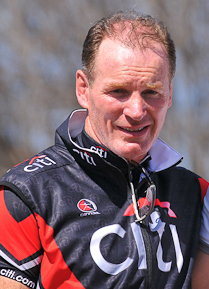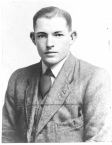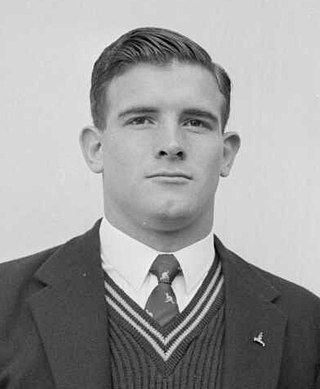Related Research Articles

The Australia men's national rugby union team, nicknamed the Wallabies, is the representative men's national team in the sport of rugby union for the nation of Australia. The team first played at Sydney in 1899, winning their first test match against the touring British Isles team.

Simon Paul Poidevin is a former Australian rugby union player who played as a flanker. Poidevin made his Test debut for Australia against Fiji during the 1980 tour of Fiji. He was a member of the Wallabies side that defeated New Zealand 2–1 in the 1980 Bledisloe Cup series. He toured with the Eighth Wallabies for the 1984 Australia rugby union tour of Britain and Ireland that won rugby union's "grand slam", the first Australian side to defeat all four home nations, England, Ireland, Wales and Scotland, on a tour. He debuted as captain of the Wallabies in a two-Test series against Argentina in 1986, substituting for the absent Andrew Slack. He was a member of the Wallabies on the 1986 Australia rugby union tour of New Zealand that beat the All Blacks, one of six international teams and second Australian team to win a Test series in New Zealand. During the 1987 Rugby World Cup, he overtook Peter Johnson as Australia's most capped Test player against Japan, captaining the Wallabies for the third time in his 43rd cap. He captained the Wallabies on a fourth and final occasion on the 1987 Australia rugby union tour of Argentina before injury ended his tour prematurely. In 1988, he briefly retired from international rugby, reversing his decision 42 days later ahead of the 1988 Bledisloe Cup series. Following this series, Poidevin returned to the Australian side for the single 1989 Bledisloe Cup Test. He returned full-time to the Australian national squad for the 1991 season. Poidevin was a member of the Wallabies that won the 1991 Rugby World Cup, after which he retired from international rugby union.
John Edward Thornett, MBE was an Australian rugby union player, who played 37 Tests for Australia between 1955 and 1967 and made an additional 77 representative match appearances. He captained Australia in 16 Test matches and on an additional 47 tour matches on the eight international rugby tours he made with Wallaby squads.
Kenneth William Catchpole was an Australian rugby union footballer. A state and national representative half-back, he played twenty-seven matches for Australia, thirteen as captain. Catchpole rose through the ranks at the Randwick club as a young man, before making his debut for New South Wales at only 19 years of age, then captaining Australia at age 21. He is considered one of Australia's greatest rugby scrumhalves.
John Brass is an Australian former rugby union and rugby league footballer – a dual-code international. He made twelve international representative rugby union appearances with the Wallabies from 1966 to 1968 and six representative rugby league appearances for the Kangaroos in 1970 and 1975, as national captain on one occasion.

Australia A is the second national Rugby union team of Australia, behind the Wallabies. Matches played under the 'Australia A' title are traditionally non-test match fixtures and often offer a stepping-stone to Wallaby national selection. Aspiring Wallaby players were given a chance to impress selectors during these games. In the past, the team would also play touring sides, such as the British & Irish Lions, or play mid-week games when the Wallabies are on tour.
The McLean family were an Australian rugby clan who between them played 77 Tests for the Australian national rugby union team and a number of Tests for the Australian national rugby league team.

William Malcolm McLean was an Australian soldier and a state and national representative rugby union player who captained the Wallabies in five Test matches immediately after World War II.

Tom Lawton Snr was an Australian rugby union player, a state and national representative five-eighth who made 44 appearances for the Wallabies, played in 14 Test matches and captained the national side on ten occasions.
Steve Williams is an Australian former state and national representative rugby union player who captained the Wallabies in five Test matches in 1985.
John Noel Brian Hipwell was an Australian national representative rugby union player who played and captained the Wallabies. He played the majority of his career at scrum half and his representative career spanned 14 seasons from 1968 to 1981.

James Kenneth Michael Lenehan was an Australian rugby union footballer. A state and national representative versatile back, he played twenty-four Test matches for Australia, once as captain. His national representative career spanned a ten-year period during which time he made two grand Wallaby tours to the northern hemisphere and Home Nations and numerous appearances against New Zealand and South Africa.
Gregory Victor Davis was a New Zealand born, national representative rugby union player for Australia. He played at flanker and made seven international tours with Wallaby squads. He was the Australian national captain in 47 matches from 1969 to 1972 and led the Wallaby side on three overseas tours.

Peter George Johnson was an Australian international rugby union player. He enjoyed a long state and international career throughout the 1960s and made 92 national appearances for his country. He captained the Australian side in five Test matches.
Geoffrey Arnold Shaw is an Australian former national representative rugby union player who played for and captained the Wallabies. He made state representative appearances for both New South Wales and Queensland over an eleven-year period from 1969.

Fraser McReight is an Australian rugby union player who plays for the Queensland Reds in Super Rugby and the Wallabies. His playing position is openside flanker.
Rex David L'Estrange is an Australian former rugby union international.
Malcolm Rignall Blair was an Australian rugby union international.
Terrance George Paul Curley was an Australian rugby union international.
Neville Allen Emery was an Australian rugby union international.
References
- ↑ "Same R.U. Test side". The Sydney Morning Herald . 6 August 1968.
- ↑ "David Aubrey Taylor". classicwallabies.com.au.
- ↑ "Rugby's greatest half makes the scene again". Tribune . 28 May 1969. p. 12 – via National Library of Australia.